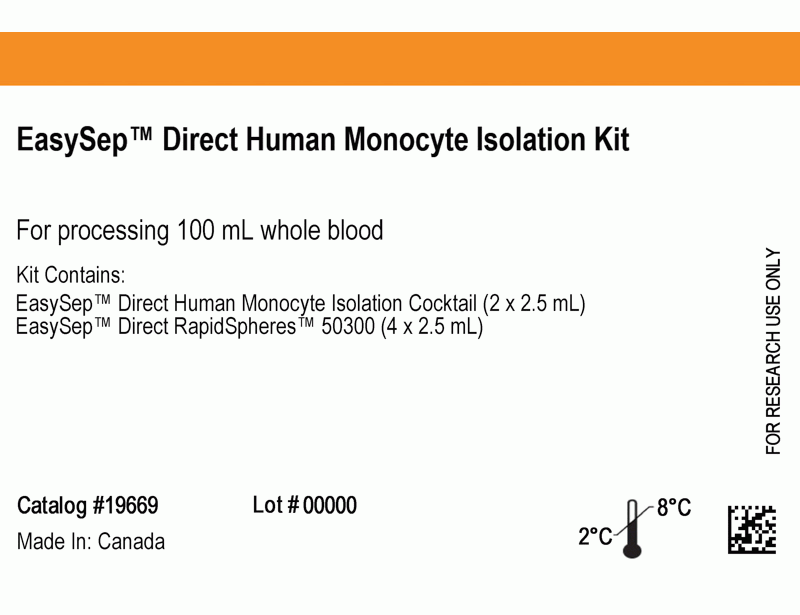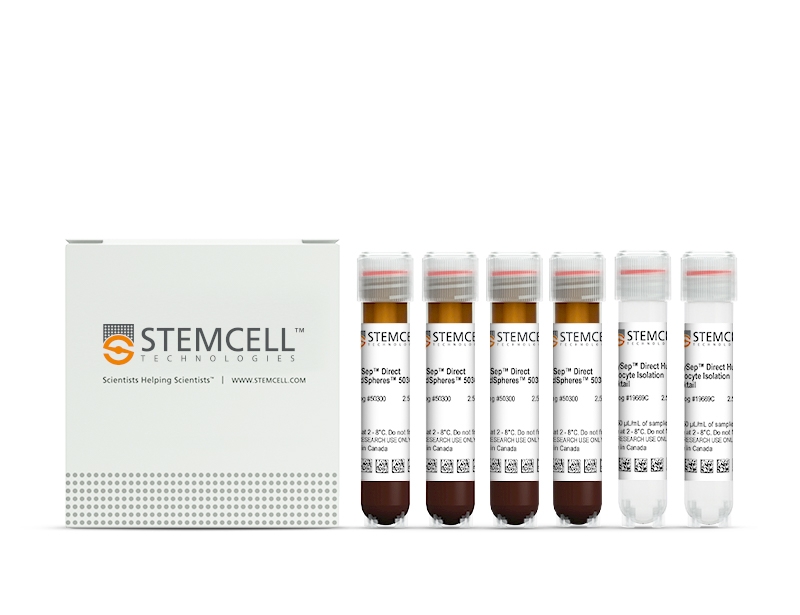EasySep™ Direct Human Monocyte Isolation Kit
Immunomagnetic negative selection from whole blood kit
概要
The EasySep™ Direct Human Monocyte Isolation Kit isolates functional, highly purified CD14+ monocytes directly from human whole blood by immunomagnetic negative selection. No lysis, density gradient centrifugation or other processing steps are required and isolated cells are immediately available for flow cytometry, functional assays, culture and other downstream applications.
Advantages
• 99.9% RBC depletion without the need for density gradient centrifugation, sedimentation, or lysis
• Up to 92% purity of isolated cells
• Fast, easy-to-use and column-free
• Isolated cells are untouched
• Up to 92% purity of isolated cells
• Fast, easy-to-use and column-free
• Isolated cells are untouched
Components
- EasySep™ Direct Human Monocyte Isolation Kit (Catalog #19669)
- EasySep™ Direct Human Monocyte Isolation Cocktail, 2 x 2.5 mL
- EasySep™ Direct RapidSpheres™, 4 x 2.5 mL
- RoboSep™ Human Monocyte Isolation Kit with Filter Tips (Catalog #19669RF)
- EasySep™ Direct Human Monocyte Isolation Cocktail, 2 x 2.5 mL
- EasySep™ Direct RapidSpheres™, 4 x 2.5 mL
- RoboSep™ Buffer (Catalog #20104)
- RoboSep™ Filter Tips (Catalog #20125) x 2
Magnet Compatibility
• EasySep™ Magnet (Catalog #18000)
• “The Big Easy” EasySep™ Magnet (Catalog #18001)
• Easy 50 EasySep™ Magnet (Catalog #18002)
• EasyEights™ EasySep™ Magnet (Catalog #18103)
• RoboSep™-S (Catalog #21000)
Subtype
Cell Isolation Kits
Cell Type
Monocytes, Myeloid Cells
Species
Human
Sample Source
Whole Blood
Selection Method
Negative
Application
Cell Isolation
Brand
EasySep, RoboSep
Area of Interest
Immunology
技术资料
| Document Type | 产品名称 | Catalog # | Lot # | 语言 |
|---|---|---|---|---|
| Product Information Sheet | EasySep™ Direct Human Monocyte Isolation Kit | 19669 | All | English |
| Product Information Sheet | EasySep™ Direct Human Monocyte Isolation Kit for RoboSep™ | 19669RF | All | English |
| Safety Data Sheet 1 | EasySep™ Direct Human Monocyte Isolation Kit | 19669 | All | English |
| Safety Data Sheet 2 | EasySep™ Direct Human Monocyte Isolation Kit | 19669 | All | English |
数据及文献
Data

Figure 1. Typical EasySep™ Direct Human Monocyte Isolation Profile
Starting with human whole blood from normal healthy donors, the typical monocyte (CD14+) content of the non-lysed final Isolated fraction is 82.2 ± 8.4% (gated on CD45) or 79.0 ± 10.1% (not gated on CD45). In the example above, the monocyte (CD14+) content of the lysed whole blood start sample and the non-lysed final isolated fraction is 6.5% and 88.3% (gated on CD45), respectively, or 6.4% and 85.7% (not gated on CD45), respectively. The starting frequency of monocytes in the non-lysed whole blood start sample above is approximately 0.007% (data not shown).
Publications (2)
Nature immunology 2017 MAY
S100-alarmin-induced innate immune programming protects newborn infants from sepsis.
Abstract
Abstract
The high risk of neonatal death from sepsis is thought to result from impaired responses by innate immune cells; however, the clinical observation of hyperinflammatory courses of neonatal sepsis contradicts this concept. Using transcriptomic, epigenetic and immunological approaches, we demonstrated that high amounts of the perinatal alarmins S100A8 and S100A9 specifically altered MyD88-dependent proinflammatory gene programs. S100 programming prevented hyperinflammatory responses without impairing pathogen defense. TRIF-adaptor-dependent regulatory genes remained unaffected by perinatal S100 programming and responded strongly to lipopolysaccharide, but were barely expressed. Steady-state expression of TRIF-dependent genes increased only gradually during the first year of life in human neonates, shifting immune regulation toward the adult phenotype. Disruption of this critical sequence of transient alarmin programming and subsequent reprogramming of regulatory pathways increased the risk of hyperinflammation and sepsis. Collectively these data suggest that neonates are characterized by a selective, transient microbial unresponsiveness that prevents harmful hyperinflammation in the delicate neonate while allowing for sufficient immunological protection.
Nature communications 2016 NOV
Germline-encoded neutralization of a Staphylococcus aureus virulence factor by the human antibody repertoire.
Abstract
Abstract
Staphylococcus aureus is both an important pathogen and a human commensal. To explore this ambivalent relationship between host and microbe, we analysed the memory humoral response against IsdB, a protein involved in iron acquisition, in four healthy donors. Here we show that in all donors a heavily biased use of two immunoglobulin heavy chain germlines generated high affinity (pM) antibodies that neutralize the two IsdB NEAT domains, IGHV4-39 for NEAT1 and IGHV1-69 for NEAT2. In contrast to the typical antibody/antigen interactions, the binding is primarily driven by the germline-encoded hydrophobic CDRH-2 motifs of IGHV1-69 and IGHV4-39, with a binding mechanism nearly identical for each antibody derived from different donors. Our results suggest that IGHV1-69 and IGHV4-39, while part of the adaptive immune system, may have evolved under selection pressure to encode a binding motif innately capable of recognizing and neutralizing a structurally conserved protein domain involved in pathogen iron acquisition.


